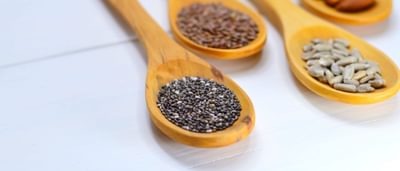

Latest Articles
Have you noticed that everyone is talking about Omega-3? We asked scientist and co-founder of Vegetology (and self-confessed science geek) Chris Smith to give you the lowdown on Omega-3 – what are they, where do you find them and are they really all they’re hyped up to be? We also wanted to know what foods are rich in Omega-3 fatty acids and how we can include more in our diet.
What Are Omega‑3 Fatty Acids?
First thing to say is that Omega-3 may sound like a villain in Transformers, but is actually not quite as exciting as that. So why the name? Chris Smith explains:
"The Omega in the name actually refers to the place with the double bonds on the fatty acid chain. These are double bonds in a fatty acid chain. The reason they're Omega-3 is purely because it's polyunsaturated fatty acids with a double bond of the third carbon."
There you go. Omega-3 are fatty acids, which get their name from their formation. Which leads us onto the next obvious question – do we need them? Everyone is talking about getting more Omega-3 into your diet but why do we need them at all?
Why Is Omega‑3 necessary?
Omega-3 is known as essential fatty acid. But is it essential? Chris explains:
“The name is no coincidence… they really are essential to our overall health, but particularly the eyes, brain, heart, health, which all require Omega-3s. They are the building blocks of so much of our bodies.”
How about an example?
“There are different forms of Omega-3, but one of the forms of Omega-3 is the principle part of the brain's grey matter, or the retina in our eye. In fact, 40% of our grey matter is made of Omega-3.”
When you put it like that, Omega-3 is definitely an essential to our daily diets! But wait, there are different forms?
DHA, EPA and ALA – Getting the Right Omega‑3
When it comes Omega-3 and nutrition, it’s really important we get the right kind of Omega-3. That starts with understanding the different types. Over to Chris:
“There are three main types of Omega-3, all of which fall into the same category, but they are really different. We are talking about DHA, EPA, and ALA.
DHA – also known as Docosahexaenoic Acid – DHA is what makes up 40% of the grey matter. It’s an absolutely vital component, of the brain and the retina.
EPA – also known as Eicosapentaenoic Acid – EPA stimulates powerful anti-inflammatory processes in the body.
ALA – also known as Alpha Linolenic Acid - ALA is an inactive form of Omega-3. It’s very commonly found but it needs to be converted by the body to be effective. The conversion rate is incredibly low, which most people don't realise.”
So when it comes to the types Omega-3 that are most useful for our bodies and nutrition, we’re looking for DHA and EPA.
What does Omega‑3 do for your body?
So we’ve talked about why they’re called an ‘essential’ fatty acid, but what are the benefits of Omega-3 in the body? This is where it’s hard to get Chris Smith to stop talking!
“It’s not a case of what does it do but almost what doesn’t it do! Omega-3 is vital for brain cell regeneration, and for generation in the first place. It’s great for cognitive function, behaviour, attentiveness, for general development. It reduces inflammation, and help inflammatory processes, which are linked to heart disease, for instance. It improves mood and has a lot of links to fighting the symptoms of depression and anxiety. It is great for the joints. It is vital during, before and after pregnancy, and aiming to get pregnant, all the way through.
Omega-3 is in the news all the time, new research coming out linking benefits to ADHD, to Alzheimer's, arthritis, just to name a few.”
Right, so we get that. Omega-3 has a ton of benefits to the body. So how do we increase our Omega-3 levels?
Your Body Cannot Make Omega‑3
It’s really important to know that your body cannot make Omega-3 in the way it can make Vitamin D, for example. You have to get Omega-3 from your diet, which means making sure you are getting sources rich in Omega-3 as part of your daily nutrition.

What sort of foods are rich in Omega‑3?
If you ask people that question, the most common answer for a good source of Omega-3 will be fish. Oily fish, in particular salmon, sardines, mackerel, krill and other crustaceans are a good source of Omega-3 (DHA and EPA – the two kinds your body needs).
Omega-3 is also found in plants and you can get some Omega-3 from nuts and seed oils. But it’s really important to note that these plant-based sources contain the type of Omega-3 called ALA, which means the the body will need to convert it to the correct type before it has any health benefits.
What If You Don’t Eat a Lot Of Fish?
We are aware that many of us don't eat a lot of fish, if any, and there are many reasons for that. For a start, the UK government now recommend that we only eat two portions of fish a week. Why is that? If it’s full of Omega-3?
“If it was just down to Omega-3, the recommendation would be to eat fish every day. However, fish are very good at capturing other things as well as Omega-3 - like mercury and toxins. That's the reason the NHS here and I guess most equivalents around the world will say eat fish, but at a limit, because yes you get Omega-3, but we don't want you going crazy from mercury poisoning. You can even have fish that swim and grow in the purest of waters but mercury levels can still be naturally very high, and dangerous in fish.”
The Problem With Nuts and Seeds
There are certain types of plants that are naturally high in Omega-3 (and not in toxins!), so does it not make sense to get our Omega-3 intake from these foods? In short, not really. Chris explains:
“The truth is they are not good sources of Omega-3. They do contain ALA, which is an Omega-3, but as we mentioned earlier, that's not the right form for the body. The body needs to convert that ALA into DHA and EPA. Here's the problem, that conversion rate is tiny. We're talking about 1% conversion for DHA, and a maximum of 5% for EPA.”

How Do We Get Enough Omega‑3?
If some of us choose not to eat oily fish, and even those who do are limited in their intake, and if nuts and seeds don’t contain the preferred type of Omega-3, that leads us to ask – how do we get enough Omega-3? Chris Smith tells us that’s where supplements come in. But hang on, aren’t supplements containing DHA and EPA also made from fish oil?
Not all. There’s a way to get the same kind of Omega-3 you get from fish oil supplements – by bypassing the middleman (or in this case, fish!)
“Fish don't naturally contain Omega-3. They get it from their diet of algae. When we eat oily fish - the big oily fish, the mackerel, are probably eating the tiny fish. The tiny fish eats a lot of algae, and therefore up the food chain goes the EPA and DHA.
It's now possible to get the Omega-3 in the form of EPA and DHA directly from that algae into supplements. It’s absolutely perfect for those that don't want to eat fish, or have ethical reasons for not wanting to eat fish, so vegans, vegetarians, to get real Omega-3 in the correct forms.”
The result is a supplement that is plant-based and actually sourced from algae grown in closed conditions, so without the impact of pollution from the sea. Supplements sourced from algae contain the types of Omega-3 the body needs but without the added pollutants, and made from plant-based, planet-friendly ingredients.
The result is a supplement that is plant-based and actually sourced from algae grown in closed conditions, so without the impact of pollution from the sea. Supplements sourced from algae contain the types of Omega-3 the body needs but without the added pollutants, and made from plant-based, planet-friendly ingredients.
FREE eBook
For more information about Omega-3 and the other essential vitamins that enable optimal health, download our Ultimate Guide to Dietary Supplements